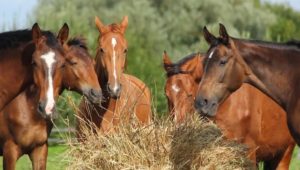Choosing the Right Hay for Your Horse
For new horses owners or even people who have been around horses for a long time, the subject of horse nutrition can be daunting. The majority of a horse’s diet consists of roughage, such as hay and grass. A typical horse may consume 20 or more pounds of roughage per day. While some horses can meet this requirement in the pasture, most horses need supplemental hay, especially when stabled or during the winter. Therefore, it is wise to take some time to consider the types and quality of hay that would be best suited to your horse.
Types of Hay
There are two main types of hay: grass and legume.
Legumes:
Legume hays are higher in protein and nutrients than grass hays. They are highly palatable and provide horses with much higher energy content. Alfalfa is the most popular type of legume hay, but red clover, white clover, and birdsfoot trefoil are other options. Keep in mind that legume hay may be too rich for certain types of horses such as “easy keepers”, elderly horses, “hot” horses, and ponies. Use caution when feeding legume hay so as not to disrupt a horse’s calcium-phosphorous ratio. Legume hay is most suitable for performance horses, lactating mares, and horses with a high caloric requirement.
Grass:
Grass hay is lower in protein and energy, but higher in fiber than legume. Horses need to eat more of this hay to meet their energy requirements, which makes is a good option for stabled horses, “easy keepers”, ponies, horses in light work, and horses prone to digestive upset. A diet of grass hay most closely mimics the diet of a horse out to pasture. For new horse owners, this type of hay is typically the best choice because there is less risk of feeding improperly and inducing colic or nutritional deficiency. Grass hays vary in different parts of the country, but examples include timothy, Bermuda, Kentucky bluegrass, and orchardgrass.
Quality of Hay
The quality of hay is just as important as the type of hay. There are a few questions you should ask yourself when evaluating hay. At what stage was the hay harvested? Hay that is overly mature can be coarse and nutrient-depleted. The first cutting of hay is almost always more mature, less nutritious, and contains more weeds than second or third cuts. How many leaves and stems are present? Damaged or overly dry hay will be mostly coarse stems. Look for hay with a higher leaf content for greater nutrition. Additionally, always check to make sure that the hay you purchase is free of dust, mold, bugs, and weeds, which could make your horse very ill in a number of ways. Good quality hay is a lovely shade of green, smells sweet, is supple to touch, and feels dense when lifted.
Written by Jada Pfeiffer
-
Articles
- April 2024
- March 2024
- February 2024
- January 2024
- December 2023
- November 2023
- October 2023
- September 2023
- August 2023
- July 2023
- June 2023
- May 2023
- April 2023
- March 2023
- February 2023
- December 2022
- November 2022
- October 2022
- September 2022
- August 2022
- July 2022
- June 2022
- May 2022
- April 2022
- March 2022
- February 2022
- January 2022
- December 2021
- November 2021
- October 2021
- September 2021
- August 2021
- July 2021
- May 2021
- April 2021
- March 2021
- February 2021
- January 2021
- December 2020
- November 2020
- October 2020
- September 2020
- August 2020
- July 2020
- June 2020
- May 2020
- April 2020
- March 2020
- February 2020
- January 2020
- December 2019
- November 2019
- October 2019
- September 2019
- August 2019
- July 2019
- June 2019
- May 2019
- April 2019
- March 2019
- February 2019
- January 2019
- December 2018
- November 2018
- October 2018
- September 2018
- August 2018
- July 2018
- June 2018
- May 2018
- April 2018
- March 2018
- February 2018
- January 2018
- November 2017
- October 2017
- September 2017
- August 2017
- July 2017
- June 2017
- May 2017
- April 2017
- March 2017
- February 2017
- January 2017
- December 2016
- October 2016
- September 2016
- August 2016
- July 2016
- June 2016
- May 2016
- April 2016
- March 2016
- February 2016
- January 2016
- December 2015
- November 2015
- October 2015
- August 2015
- June 2015
- May 2015
- March 2015
- November 2014
- March 2014
- October 2013
- September 2013
- August 2013
- January 2013
- December 2012
- November 2012
- October 2012
- September 2012
- January 2012
- October 2011
- September 2011
- August 2011
- July 2011
- June 2011
- February 2011
-
Meta





